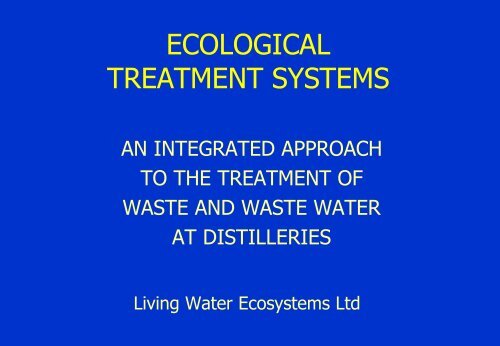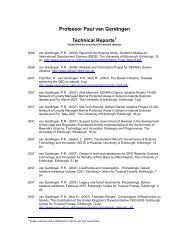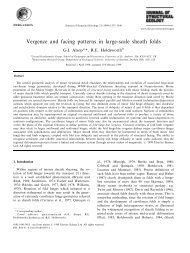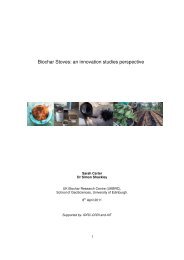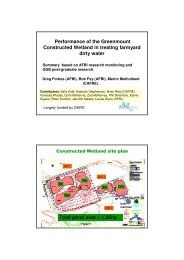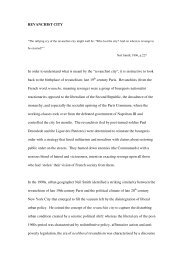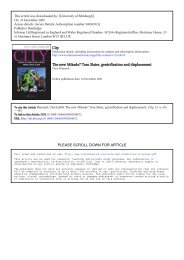Jane Shields (Living Water Ecosystems Ltd.)
Jane Shields (Living Water Ecosystems Ltd.)
Jane Shields (Living Water Ecosystems Ltd.)
Create successful ePaper yourself
Turn your PDF publications into a flip-book with our unique Google optimized e-Paper software.
ECOLOGICAL<br />
TREATMENT SYSTEMS<br />
AN INTEGRATED APPROACH<br />
TO THE TREATMENT OF<br />
WASTE AND WASTE WATER<br />
AT DISTILLERIES<br />
<strong>Living</strong> <strong>Water</strong> <strong>Ecosystems</strong> <strong>Ltd</strong>
Introduction<br />
<strong>Living</strong> <strong>Water</strong> <strong>Ecosystems</strong> <strong>Ltd</strong> has been<br />
designing and implementing natural<br />
treatment systems since 1989<br />
This presentation will show how ecological<br />
principles are applied to treatment systems<br />
and how an integrated strategy is achieved
Ecological Principles<br />
In nature there is no waste, because the<br />
waste of one organism is food for another<br />
Inherent in this are the concepts of nutrient<br />
balancing, carrying capacity and completing<br />
& linking cycles with the food web<br />
Complexity and diversity are necessary for<br />
a healthy ecology
Constructed Wetlands<br />
Constructed wetlands utilise symbiotic<br />
relationships found at the soil/water<br />
interface in natural marsh ecosystems<br />
These relationships between bacteria and<br />
other microorganisms, animals and algae<br />
are responsible for most of the world’s<br />
naturally pure water
Wetland Ecology<br />
Our treatment systems incorporate a wide<br />
variety of wetland plants, bacteria, fungi,<br />
invertebrates and algae<br />
We employ complex ecological relationships<br />
to create a ‘food web’ which enables waste<br />
products to be transformed into plant and<br />
animal biomass
<strong>Living</strong> <strong>Water</strong> Wetlands:<br />
Combine vertical and horizontal flows<br />
Contain air to maximise oxygen in beds<br />
Discharge effluent at the soil / water<br />
interface - the most active zone<br />
Use an aerobic environment to efficiently<br />
break down high-strength effluents such as<br />
distillery waste
<strong>Living</strong> <strong>Water</strong> Wetlands are:<br />
Designed to suit the task<br />
Planted with up to 56 native species of<br />
wetland plant to optimise treatment and<br />
system resilience<br />
Landscaped into the surrounds and<br />
designed to maximise biodiversity
Integrated Strategy<br />
1. Assess how water and waste at the site<br />
can be reduced, eliminated or<br />
transformed into a resource<br />
2. Develop systems for on-site management<br />
and treatment of effluent and solid waste<br />
3. Provide for surface water attenuation,<br />
treatment and recycling/re-use
Integrated Strategy<br />
4. Ecological on-site treatment of the<br />
remaining contaminated water and waste<br />
5. Landscaping to create habitat and<br />
increase biodiversity<br />
6. A degree of flexibility to allow for<br />
expansion and climate change
Surface <strong>Water</strong> Management<br />
Reduce run-off from site, especially during<br />
storm events<br />
Provide surface water attenuation,<br />
treatment and recycling<br />
Capture and recycle roof water
Glenfiddich Distillery<br />
Discharge is to a salmon river. Ecological<br />
treatment system was designed to:<br />
Polish the effluent discharging from three<br />
distilleries (Glenfiddich, Balvenie and Kininvie)<br />
with particular emphasis on the removal of<br />
copper, suspended solids and BOD<br />
Act as a buffer in extreme cases such as a<br />
major power failure at the effluent plant
Glenfiddich Distillery<br />
System became operational in 2000<br />
Treatment area 980 m 2 , in five beds.<br />
Two new beds and pond added in 2005,<br />
increasing area to 1520 m 2<br />
No mechanical equipment associated with<br />
the operation of the ecological treatment<br />
system, which is gravity-fed. Input needed<br />
from effluent operators is therefore minimal
Glenfiddich Distillery
Glenfiddich: Design Criteria<br />
Ecological treatment system originally<br />
designed to treat 40 m 3 per hour = 960 m 3<br />
per day for a 24 / 7 operation<br />
In 2005 system expanded to treat 50 m 3 per<br />
hour (1200 m3 per day)<br />
System now treats 1200 m 3 /day of effluent<br />
containing ~120 kg of BOD, 144 kg of<br />
suspended solids and 0.9 kg of copper
Glenfiddich: Design Criteria<br />
Copper removal is by direct uptake by the<br />
plants as a micronutrient. It is absorbed<br />
onto the starch in the roots and rhizomes<br />
through ionic bonding<br />
Copper continues to bind to the starch of<br />
the continually growing plant starch and<br />
does not pass into the leaf matter, which<br />
can be safely composted
Glenfiddich Results<br />
The ecological treatment system achieves<br />
overall biological removal efficiencies in<br />
excess of 95%<br />
Treatment system averages 92% reduction<br />
in suspended solids<br />
The effluent has residual copper levels of<br />
less than 0.5 ppm
Glengoyne Distillery<br />
Ecological treatment system designed to remove<br />
copper and nutrients from spent lees, wash waters,<br />
boiler blowdown and sewage. Discharge is to a river<br />
Pot ale separated from spent lees so that anaerobic<br />
digestion of pot ale could be a viable option<br />
Surface water attenuation and SUDS measures<br />
installed to manage run-off from new warehouses<br />
Gravity-fed system (with spent lees pumped)<br />
became operational in May 2011
Glengoyne Distillery<br />
Daily volume entering system is 10.5 m 3 of<br />
spent lees, ~2 m 3 /of wash waters and ~7 m 3<br />
of sewage<br />
With little land available, treatment area of<br />
1239 m 2 is divided into 12 wetland beds: 4<br />
series of 3 beds each. Each series can be<br />
rested in turn<br />
Total number of plants (21 species) for<br />
wetland cells and swale: 13,500
Glengoyne: Design Criteria<br />
Distillery operates 24 hours per day, 7 days<br />
a week for 46 weeks per year, with a new<br />
production batch every 7 hours. Three<br />
batches need to be treated per day<br />
Volume of spent lees =10.30 m3 per day,<br />
i.e. 82.40 m3 in a 7-day production week
Glengoyne Distillery: Design Criteria<br />
Design criteria for the daily loading are<br />
as follows:<br />
BOD 32 kg<br />
TSS 42 kg<br />
FOG 5.5 kg<br />
TDS 37 kg<br />
COD 70 kg<br />
NH4-N 0.033 kg<br />
Total N 0.099 kg<br />
PO4 0.322 kg
Glengoyne Distillery: Results<br />
At an age of only one year, and with its<br />
ecology still evolving, the ecological<br />
treatment system is achieving overall<br />
removal efficiencies in excess of 95% for<br />
all parameters listed in the design criteria
Glengoyne Distillery
Company Contact Details<br />
<strong>Jane</strong> <strong>Shields</strong> and David <strong>Shields</strong><br />
Directors<br />
<strong>Living</strong> <strong>Water</strong> <strong>Ecosystems</strong> <strong>Ltd</strong><br />
Carlingnose Studios<br />
North Queensferry<br />
Fife, KY11 1ER<br />
Scotland, UK<br />
www.livingwater.org.uk<br />
t: +44 (0)1383 415215<br />
m: +44 (0)7932 120516 / 515<br />
e: janes@livingwater.org.uk<br />
e: davids@livingwater.org.uk


